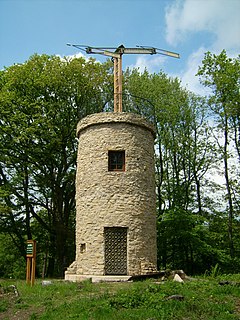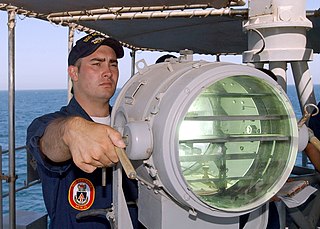
Morse code is a method used in telecommunication to encode text characters as standardized sequences of two different signal durations, called dots and dashes or dits and dahs. Morse code is named after Samuel Morse, an inventor of the telegraph.

Packet radio is a digital radio communications mode used to send packets of data. Packet radio uses packet switching to transmit datagrams. This is very similar to how packets of data are transferred between nodes on the Internet. Packet radio can be used to transmit data long distances.

Radioteletype (RTTY) is a telecommunications system consisting originally of two or more electromechanical teleprinters in different locations connected by radio rather than a wired link. These machines were superseded by personal computers (PCs) running software to emulate teleprinters. Radioteletype evolved from earlier landline teleprinter operations that began in the mid-1800s. The US Navy Department successfully tested printing telegraphy between an airplane and ground radio station in 1922. Later that year, the Radio Corporation of America successfully tested printing telegraphy via their Chatham, Massachusetts, radio station to the R.M.S. Majestic. Commercial RTTY systems were in active service between San Francisco and Honolulu as early as April 1932 and between San Francisco and New York City by 1934. The US military used radioteletype in the 1930s and expanded this usage during World War II. From the 1980s, teleprinters were replaced by computers running teleprinter emulation software.

Telegraphy is the long-distance transmission of textual messages where the sender uses symbolic codes, known to the recipient, rather than a physical exchange of an object bearing the message. Thus flag semaphore is a method of telegraphy, whereas pigeon post is not. Ancient signalling systems, although sometimes quite extensive and sophisticated as in China, were generally not capable of transmitting arbitrary text messages. Possible messages were fixed and predetermined and such systems are thus not true telegraphs.

Wireless telegraphy or radiotelegraphy is transmission of telegraph signals by radio waves. Before about 1910, the term wireless telegraphy was also used for other experimental technologies for transmitting telegraph signals without wires, such as electromagnetic induction, and ground conduction telegraph systems.

In telecommunications, a repeater is an electronic device that receives a signal and retransmits it. Repeaters are used to extend transmissions so that the signal can cover longer distances or be received on the other side of an obstruction. Some types of repeaters broadcast an identical signal, but alter its method of transmission, for example, on another frequency or baud rate.
The Q-code is a standardized collection of three-letter codes all of which start with the letter "Q". It is an operating signal initially developed for commercial radiotelegraph communication and later adopted by other radio services, especially amateur radio. To distinguish the use of a Q-code transmitted as a question from the same Q-code transmitted as a statement, operators either prefixed it with the military network question marker "INT" or suffixed it with the standard Morse question mark UD.

Broadcasting is the distribution of audio or video content to a dispersed audience via any electronic mass communications medium, but typically one using the electromagnetic spectrum, in a one-to-many model. Broadcasting began with AM radio, which came into popular use around 1920 with the spread of vacuum tube radio transmitters and receivers. Before this, all forms of electronic communication were one-to-one, with the message intended for a single recipient. The term broadcasting evolved from its use as the agricultural method of sowing seeds in a field by casting them broadly about. It was later adopted for describing the widespread distribution of information by printed materials or by telegraph. Examples applying it to "one-to-many" radio transmissions of an individual station to multiple listeners appeared as early as 1898.

Optical communication, also known as optical telecommunication, is communication at a distance using light to carry information. It can be performed visually or by using electronic devices. The earliest basic forms of optical communication date back several millennia, while the earliest electrical device created to do so was the photophone, invented in 1880.

Automatic Packet Reporting System (APRS) is an amateur radio-based system for real time digital communications of information of immediate value in the local area. Data can include object Global Positioning System (GPS) coordinates, weather station telemetry, text messages, announcements, queries, and other telemetry. APRS data can be displayed on a map, which can show stations, objects, tracks of moving objects, weather stations, search and rescue data, and direction finding data.

Frank Conrad was an electrical engineer, best known for radio development, including his work as a pioneer broadcaster. He worked for the Westinghouse Electrical and Manufacturing Company in East Pittsburgh, Pennsylvania for half a century. His experimental radio station provided the inspiration, and he acted in an advisory role, for the establishment of Westinghouse's first broadcasting service, over radio station KDKA.

An amateur radio station is a radio station designed to provide radiocommunications in the amateur radio service for an amateur radio operator. Radio amateurs build and operate several types of amateur radio stations, including fixed ground stations, mobile stations, space stations, and temporary field stations. A slang term often used for an amateur station's location is the shack, named after the small enclosures added to the upperworks of naval ships to hold early radio equipment and batteries.

In times of crisis and natural disasters, amateur radio is often used as a means of emergency communication when wireline, cell phones and other conventional means of communications fail.

Vintage amateur radio is a subset of amateur radio hobby where enthusiasts collect, restore, preserve, build, and operate amateur radio equipment from bygone years, such as those using vacuum tube technology. Popular modes of operation include speaking over amplitude modulation (AM), and communicating using Morse code through continuous wave (CW) radiotelegraphy. Some enthusiasts have interest in owning, restoring and operating vintage military and commercial radio equipment such as those from 1940s to 1960s. Some undertake to construct their own gear, known in ham slang as homebrewing, using vintage parts and designs. A number of amateur radio clubs and organizations sponsor contests, events, and swap meets that cater to this specialized aspect of the hobby.
The history of amateur radio, dates from the dawn of radio communications, with published instructions for building simple wireless sets appearing at the beginning of the twentieth century. Throughout its history, amateur radio enthusiasts have made significant contributions to science, engineering, industry, and social services. Research by amateur radio operators has founded new industries, built economies, empowered nations, and saved lives in times of emergency.
A radiogram is a formal written message transmitted by radio. Also known as a radio telegram or radio telegraphic message, radiograms use a standardized message format, form and radiotelephone and/or radiotelegraph transmission procedures. These procedures typically provide a means of transmitting the content of the messages without including the names of the various headers and message sections, so as to minimize the time needed to transmit messages over limited and/or congested radio channels. Various formats have been used historically by maritime radio services, military organizations, and Amateur Radio organizations.

KPH is a public coast radio station on the West Coast of the United States. For most of the 20th century, it provided ship to shore communications including telegrams and marine telex service. The station discontinued commercial operation in 1998, but is operated occasionally as a historic service – its signal can be tuned in throughout a large portion of the western hemisphere.
An amateur radio net, or simply ham net, is an "on-the-air" gathering of amateur radio operators. Most nets convene on a regular schedule and specific frequency, and are organized for a particular purpose, such as relaying messages, discussing a common topic of interest, in severe weather, emergencies, or simply as a regular gathering of friends for conversation.

Amateur radio, also known as ham radio, is the use of radio frequency spectrum for purposes of non-commercial exchange of messages, wireless experimentation, self-training, private recreation, radiosport, contesting, and emergency communication. The term "amateur" is used to specify "a duly authorised person interested in radioelectric practice with a purely personal aim and without pecuniary interest;" and to differentiate it from commercial broadcasting, public safety, or professional two-way radio services.













